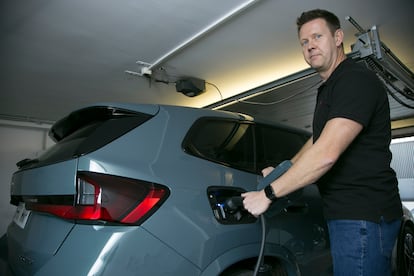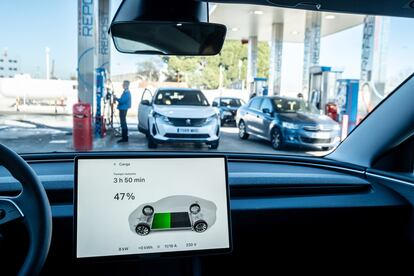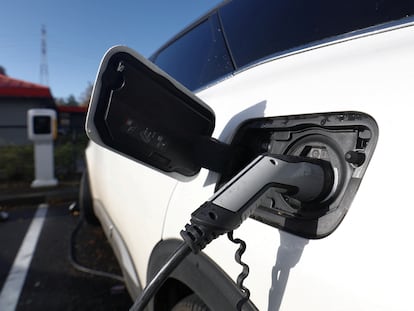Electric car myths: They are prone to catch fire, take a long time to charge and are not suitable for long trips
Zero-emission vehicles generate a lot of unfounded information and exaggeration, partly because a majority of the population has not yet tried them


“Electric cars constantly catch fire.” “They take many hours to charge.” “The batteries don’t have enough autonomy.”“There is nowhere to charge them.” “For a long trip you need a diesel.” Zero-emission vehicles generate a lot of unfounded information and exaggeration, partly because a majority of the population has not yet tried them: according to the Spanish Association of Car and Truck Manufacturers (Anfac), 54,857 electric vehicles were sold in Spain in 2023, 5.7% of the total. We analyze the main myths surrounding electrical vehicles (EVs) — some of which hold an element of truth — with the help of industry experts.
“They go up in flames at the drop of a hat”
This is untrue. “The fire rates of electric vehicles are lower than those of combustion vehicles, as the NHTSA — the U.S. state road safety agency — has shown in its reports,” says David de Diego, a legal expert in electric vehicles at the Spanish APCAS breakdown insurance association. “These vehicles can catch fire due to a very strong impact, or due to a manufacturing fault. What is true is that when they burn they enter an electrochemical spiral, and you have to know how to put them out, because pouring water on it does not work. It’s better to use thermal blankets that smother the fire.” Norway, the country with the highest number of electric cars in the world, has registered four to five times more fires in gasoline and diesel cars than in electric cars. Meanwhile, the European Lashfire project concluded that neither the total energy nor the toxins released during a fire in an electric car are greater than those caused by a combustion vehicle.
“They break down all the time”
Also not true. “The electric vehicle differs with respect to its combustion counterparts in the simplicity of its mechanics as, in the absence of elements exposed to friction or wear, it requires hardly any repairs and its revisions are very straightforward,” says Arturo Pérez de Lucia, director of Aedive, the Spanish electric vehicle employer’s association. Luis Valdés, an expert on electric mobility, adds: “Most manufacturers give very high warranties, of 150,000 and even up to 200,000 kilometers (124,274 miles), because they know that it is very difficult for them to break down.”

“You have to change the battery after seven years”
Probably not. “LFP type batteries, the most common, can last from 2,000 to 5,000 cycles. If a cycle is 500 kilometers, that would be between one and 2.5 million kilometers. The only thing that could happen before that is that you lose a little autonomy [no more than 10%],” says Lars Hoffman, an EV tester on the All Electric channel on YouTube. It is true that a few years ago there was greater degradation of the battery, but now this is no longer the case and they are also covered by the manufacturers’ warranty. De Diego points out: “Batteries are evolving every year and react better than expected. In addition, electric drivers tend to drive more efficiently to recharge the engine, which extends the life of the battery.”
“There are too few recharging points”
Aedive states that as of October 2023 there were 27,420 public access charging points in Spain, so the year-end data will be close to 30,000. A further 8,000 are in the administrative process. “With today’s batteries and high-power recharging, the experience of use is similar to that of combustion vehicles,” says Pérez de Lucia. However, it is true that ultra-fast chargers of more than 150 kilowatts (kw/h) only make up 6% of the total, according to a count by EL PAÍS. On the main highways there are usually no issues but in more remote areas it is advisable to plan the trip and any stops beforehand. “Traveling with an electric car is simple; the problem lies more in the lack of slow-charging points in the city, for those who do not have a garage,” says Valdés.
“Batteries have little autonomy”
One of the most widespread myths is that batteries offer little autonomy. “The problem is that some people think they have to last for 800 kilometers, like a diesel, but the truth is that on a day-to-day basis it is rare to do more than 200 or 300 kilometers and for that, the current autonomies are sufficient,” says Félix García, spokesman for Anfac, the automobile employers’ association. Hoffman adds: “Nowadays, any electric vehicle costing between €30,000 and €40,000 can cover 300 kilometers on the highway, and much more in the city.” Miguélez, from Ganvam, points out that most electric vehicles can already be driven in normal use in the city on a single charge for the whole week. It is true that vehicles with more autonomy, from 600 to 700 kilometers, are in the higher price range. “It is not often mentioned that the range increases when you slow down or drive downhill. This is one of the great pleasures of driving an electric car: seeing how the battery is recharged by driving efficiently and taking advantage of downhill slopes,” says May López, of the Businesses for Sustainable Mobility (EMS) association.
“They take a long time to charge”
This depends. “You have to bear in mind that there are two types of charging: slow charging, which you do at home, and which can take eight to 10 hours, and fast charging, which is more occasional and during trips, which can take 15 to 30 minutes,” says Hoffman. “But if you think about it, it’s normal to stop, have a coffee and use the bathroom, so the travel time doesn’t increase much. And it’s far outweighed by slow charging, where you just plug it in and forget about it, whereas with a combustion engine you’d have to go to the gas station once or twice a week.” Miguélez, from Ganvam, adds: “In addition, there are more and more convenience rechargers, which can be used in supermarkets or public parking lots while doing other activities.”

“You can’t buy an electric if you don’t have a garage”
In this case, there is a certain basis for the criticism. “If you don’t have a regular slow charging point, which can be at home or at work, it’s not an ideal situation,” acknowledges Álvaro Sauras, vice-president of the Association of Electric Vehicle Users (AUVE) and editor of Autofácil magazine. It is a hindrance in a country where 65% of the population lives in apartments and 16% in rented accommodation (according to data from the Spanish National Statistics Institute), meaning that many urban dwellers do not have a garage or a parking space nearby. “To make it easier, we would have to introduce many slow charging points in cities, as is already the case in the Netherlands or the United Kingdom, where almost every lamppost can be converted into one,” he adds.
“They are only good for getting around the city”
Some of the cheapest EVs are designed for urban journeys that do not exceed 200 kilometers a day, while the mid-range allows you to travel just over 300 kilometers on the highway. “Those who drive with the sole interest of arriving quickly and without stopping will still prefer a combustion car, but for a normal trip with stops you won’t take longer,” says Hoffman, who adds: “I’ve been traveling in electric vehicles for five years and I’ve never had a problem. For example, I’ve gone from Madrid to Warsaw in two days.” Miguélez, from Ganvam, suggests: “Electric rental cars —carsharing — which is very popular in cities, make a lot of sense in rural areas because they favor the use of shared vehicles in unpopulated areas.”
“You need 25 apps to recharge”
It’s a bit of an exaggeration but it has an element of truth. “Many electric users have between eight and 10 recharging apps, although there are more and more points where you can pay by card,” notes Sauras. García, of Anfac, adds: “There are applications that allow you to pay at different companies, but there is still a lack of interoperability between operators.” He points to Portugal, which has implemented a universal payment system at recharging points. “They triple Spain in pure electric sales; it is clear that there is something we are not doing right. We don’t need to invent anything, we just need to copy these countries,” he says. Valdés, an EV driver for years, explains: “I travel all over Spain with four apps that I trust, but we need a unified registry that works in real time.”

Sign up for our weekly newsletter to get more English-language news coverage from EL PAÍS USA Edition
Tu suscripción se está usando en otro dispositivo
¿Quieres añadir otro usuario a tu suscripción?
Si continúas leyendo en este dispositivo, no se podrá leer en el otro.
FlechaTu suscripción se está usando en otro dispositivo y solo puedes acceder a EL PAÍS desde un dispositivo a la vez.
Si quieres compartir tu cuenta, cambia tu suscripción a la modalidad Premium, así podrás añadir otro usuario. Cada uno accederá con su propia cuenta de email, lo que os permitirá personalizar vuestra experiencia en EL PAÍS.
¿Tienes una suscripción de empresa? Accede aquí para contratar más cuentas.
En el caso de no saber quién está usando tu cuenta, te recomendamos cambiar tu contraseña aquí.
Si decides continuar compartiendo tu cuenta, este mensaje se mostrará en tu dispositivo y en el de la otra persona que está usando tu cuenta de forma indefinida, afectando a tu experiencia de lectura. Puedes consultar aquí los términos y condiciones de la suscripción digital.
More information
Archived In
Últimas noticias
Most viewed
- Sinaloa Cartel war is taking its toll on Los Chapitos
- Oona Chaplin: ‘I told James Cameron that I was living in a treehouse and starting a permaculture project with a friend’
- Reinhard Genzel, Nobel laureate in physics: ‘One-minute videos will never give you the truth’
- Why the price of coffee has skyrocketed: from Brazilian plantations to specialty coffee houses
- Silver prices are going crazy: This is what’s fueling the rally










































